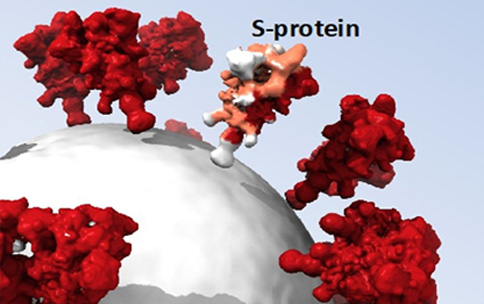
In late 2019, the virus SARS-CoV-2 was identified as the cause of the novel respiratory disease COVID-19. Many biomedical research groups shifted their focus to SARS-CoV-2 at unprecedented speeds, including the National Center for CryoEM Access & Training (NCCAT) in New York City, one of three national centers for cryoelectron microscopy (cryoEM) supported by the NIH Common Fund’s Transformative High-Resolution Cryoelectron Microscopy (CryoEM) program. CryoEM is a structural biology technique that can obtain high-resolution (highly detailed) images of molecules, such as parts of a virus. It is also becoming an established method in the development of vaccines and therapeutics, because visualizing the structures of the molecules can provide critical insights. Instruments used for cryoEM can be expensive and require specialized training, which often prohibits their use by researchers. As part of the CryoEM program’s goal to broaden access to high-resolution cryoEM, NCCAT granted multiple research groups studying COVID-19 rapid access to its cutting-edge cryoEM instruments and resources.
For researchers with cryoEM experience, the largest barrier to completing their projects was the amount of time needed on the instruments to collect multiple, large data sets. The state-of-the-art microscopes and cameras available at NCCAT allowed for speedy data acquisition, with some research groups obtaining high-resolution image reconstructions the same day data collection started. Additionally, research groups without cryoEM expertise were able to work with NCCAT staff to overcome technical challenges with instrumentation use that would have otherwise slowed data collection and interpretation.
Amidst a global pandemic, foundational knowledge uncovered by researchers accessing NCCAT is accelerating strategies to respond to the virus and to lessen the impact of COVID-19. For example, data collected on SARS-CoV-2 focused on characterizing the S-protein found on the virus surface. The S-protein binds to human cells, allowing for infection, and antibodies that defend the body from infection attach to the S-protein. Researchers using NCCAT’s resources characterized antibodies from COVID-19 patients and provided cryoEM images of the S-protein attached to these antibodies. When combined with new data on the structure of a SARS-CoV-2 variant’s S-protein, this shed important new light on how antibodies bind to SARS-CoV-2 variants. Other researchers using NCCAT described the structure of the viral helicase, a protein the virus uses to replicate and spread. Data collected at NCCAT have also been combined with other types of data to advance the development of reagents and test kits (for diagnosis), laboratory assays (for basic research), and vaccines and therapeutics (to prevent and treat the disease). Thus, the quick pivot of NCCAT to COVID-related research has led to important contributions against the pandemic on multiple fronts.
The specific research projects listed here were not financially supported by the Common Fund's CryoEM program.
References:
Controlling the SARS-CoV-2 spike glycoprotein conformation. Rory Henderson, Robert J. Edwards, Katayoun Mansouri, Katarzyna Janowska, Victoria Stalls, Sophie M. C. Gobeil, Megan Kopp, Dapeng Li, Rob Parks, Allen L. Hsu, Mario J. Borgnia, Barton F. Haynes, Priyamvada Acharya. Nature Structure & Molecular Biology, 2020, 27, 925–933.
Potent neutralizing antibodies against multiple epitopes on SARS-CoV-2 spike. Lihong Liu, Pengfei Wang, Manoj S. Nair, Jian Yu, Micah Rapp, Qian Wang, Yang Luo, Jasper F.-W. Chan, Vincent Sahi, Amir Figueroa, Xinzheng V. Guo, Gabriele Cerutti, Jude Bimela, Jason Gorman, Tongqing Zhou, Zhiwei Chen, Kwok-Yung Yuen, Peter D. Kwong, Joseph G. Sodroski, Michael T. Yin, Zizhang Sheng, Yaoxing Huang, Lawrence Shapiro & David D. Ho. Nature, 2020, 584, 450–456.
Structural Basis for Helicase-Polymerase Coupling in the SARS-CoV-2 Replication-Transcription Complex. James Chen, Brandon Malone, Eliza Llewellyn, Michael Grasso, Patrick M.M. Shelton, Paul Dominic B. Olinares, Kashyap Maruthi, Edward T. Eng, Hasan Vatandaslar, Brian T. Chait, Tarun M. Kapoor, Seth A. Darst, Elizabeth A. Campbell. Cell, 2020, 182, 1560-1573.e13.
Structure-Based Design with Tag-Based Purification and In-Process Biotinylation Enable Streamlined Development of SARS-CoV-2 Spike Molecular Probes. Tongqing Zhou, I-Ting Teng, Adam S. Olia, Gabriele Cerutti, Jason Gorman, Alexandra Nazzari, Wei Shi, Yaroslav Tsybovsky, Lingshu Wang, Shuishu Wang, Baoshan Zhang, Yi Zhang, Phinikoula S. Katsamba, Yuliya Petrova, Bailey B. Banach, Ahmed S. Fahad, Lihong Liu, Sheila N. Lopez Acevedo, Bharat Madan, Matheus Oliveira de Souza, Xiaoli Pan, Pengfei Wang, Jacy R. Wolfe, Michael Yin, David D. Ho, Emily Phung, Anthony DiPiazza, Lauren A. Chang, Olubukola M. Abiona, Kizzmekia S. Corbett, Brandon J. DeKosky, Barney S. Graham, John R. Mascola, John Misasi, Tracy Ruckwardt, Nancy J. Sullivan, Lawrence Shapiro, Peter D. Kwong. Cell Reports, 2020, 33, 108322.
Cryo-EM Structures of SARS-CoV-2 Spike without and with ACE2 Reveal a pH-Dependent Switch to Mediate Endosomal Positioning of Receptor-Binding Domains. Tongqing Zhou, Yaroslav Tsybovsky, Jason Gorman, Micah Rapp, Gabriele Cerutti, Gwo-Yu Chuang, Phinikoula S Katsamba, Jared M Sampson, Arne Schön, Jude Bimela, Jeffrey C Boyington, Alexandra Nazzari, Adam S Olia, Wei Shi, Mallika Sastry, Tyler Stephens, Jonathan Stuckey, I-Ting Teng, Pengfei Wang, Shuishu Wang, Baoshan Zhang, Richard A Friesner, David D Ho, John R Mascola, Lawrence Shapiro, Peter D Kwong. Cell Host & Microbe, 2020, 28, 867-879.e5.
Characterization of the SARS-CoV-2 S Protein: Biophysical, Biochemical, Structural, and Antigenic Analysis. Natalia G. Herrera, Nicholas C. Morano, Alev Celikgil, George I. Georgiev, Ryan J. Malonis, James H. Lee, Karen Tong, Olivia Vergnolle, Aldo B. Massimi, Laura Y. Yen, Alex J. Noble, Mykhailo Kopylov, Jeffrey B. Bonanno, Sarah C. Garrett-Thomson, David B. Hayes, Robert H. Bortz III, Ariel S. Wirchnianski, Catalina Florez, Ethan Laudermilch, Denise Haslwanter, J. Maximilian Fels, M. Eugenia Dieterle, Rohit K. Jangra, Jason Barnhill, Amanda Mengotto, Duncan Kimmel, Johanna P. Daily, Liise-anne Pirofski, Kartik Chandran, Michael Brenowitz, Scott J. Garforth, Edward T. Eng, Jonathan R. Lai, Steven C. Almo. ACS Omega, 2021, 6, 85–102.


